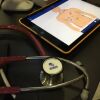A U.S. Department of Labor article “Musculoskeletal Disorders in EMS” points out that EMTs and paramedics have the highest injury rate of any line of work. Almost half of all lost work time in EMS is transportation related, and often stems from the challenges that come with moving and lifting heavy patients
Getting a patient out of tight spaces, down stairs, and on and off the stretcher makes this a physical job. But specialized tools for moving patients can often help avoid injuries, reduce lost work hours and even save careers.
Binder Lift recently introduced a new fluid-resistant version of their product called the Ultra-V. The Binder Lift fits around the torso and under the arms, and is padded around the top edge to allow you to easily move people, especially out of tight spaces.
It’s ideal for a simple lift-assist call, tricky bathroom extrications or getting somebody out of the back bedroom of a singlewide trailer. Once you get them on the cot you can leave it in place to make it easier to do the bed transfer at the hospital. Available in two sizes, with one up to 84 inches, it’s also perfect for your oversized patients. It uses coated fabrics and super-strong webbing to make it easy to clean.
The Doty Belt essentially puts handles on the patient. It looks like a lifting belt, but it is for the patient, not the responder. Once it’s quickly and conveniently attached, it provides four comfortable grip handles around your patient’s waist.
The quality of construction is excellent. It looks like all load-bearing hardware made more like a rescue harness than a typical lifting belt. The Doty Belt could make some difficult situations much more manageable.
The HILT is for seated or prone patients. It looks like a soft stretcher made of rugged seat-belt grade webbing. You fold or unfold to fit your patient and their position, and it offers a range of secure grip locations at different heights.
At first I found it a little confusing, but the more you work with it the easier it gets. It is incredibly versatile; you can do six different types of lifts with it. You can lift and carry a supine patient, seated patient, or even a patient on a backboard.
Having the right tool for the job can reduce injuries and promote a healthy workplace. These simple solutions are also affordable and we should soon see much broader adoption.



